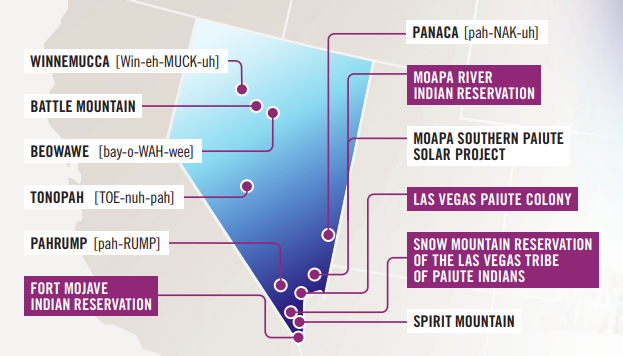Native American culture and heritage thrives throughout Nevada’s vast landscape. Indigenous Peoples who have called this land their home for hundreds of years have reservations, where many of them reside today. Highlighted on the map below are those in southern Nevada. Did you know that across Nevada’s 110,567 square miles there are names of towns which are derived from, or inspired by, Native American languages?

Town Names & Tribal Reservations
Pahrump – Originally home to various Indigenous groups including the Southern Paiute people, its name derives from the Paiute word “Pah-Rimpi” which referred to the natural springs found in the area.
Tonopah – Originally a mining town, Tonopah is believed to derive its name from the Shoshone word “Tonampaa,” meaning “hidden spring.”
Panaca – Located in eastern Lincoln County, Nevada, the town of Panaca derives its name from the Southern Paiute words “Pan-nuk-ker,” or “metal, money, and wealth.”
Battle Mountain – Once the headquarters of the Nevada Central Railroad, its name refers to an 1850 conflict between California immigrants in the area and a band of local Shoshone peoples.
Winnemucca – The town of Winnemucca was named after the 19th Century leader of the Northern Paiutes, Chief Winnemucca. Winnemucca’s daughter, Sarah, went on to be a famed advocate for Native American rights. The name translates to “one moccasin,” referring an early interaction between travelers and Chief Winnemucca, who was wearing only one moccasin.
Beowawe – An unincorporated community home to a geothermal power plant, this town derives its name from the Paiute word for “gate,” referring to the shape of nearby hills.
Washoe – Located on the state’s northwest border with California, this county is named after the Washo peoples, the ancestral inhabitants of the area around Lake Tahoe. They refer to their ancestral home as “Da ow,” or “lake.”
Spirit Mountain – On March 21, 2023, President Joe Biden officially designated the 506,000 acre area around Spirit Mountain in Southern Nevada as the Avi Kwa Ame National Monument, providing it federal protection. The site is sacred to the Fort Mojave Indian Tribe’s “spiritual ideology and in Mojave creation beliefs.”
Moapa Southern Paiute Solar Project – Built in 2017 across 2,000 acres of the Moapa River Indian Reservation, around 30 miles northeast of Las Vegas, the solar array is the first large-scale solar project to receive construction approval on a tribal land in North America.
Las Vegas Paiute Colony – Established in 1911 after being deeded to the Las Vegas Paiute Tribe by Helen J. Stewart through the Bureau of Indian Affairs, the Las Vegas Paiute Colony is located within downtown Las Vegas. Until 1983, this was the Tribe’s sole land in the area.
Snow Mountain Reservation of the Las Vegas Tribe of Paiute Indians – Located eighteen miles northwest of their original settlement in downtown Las Vegas, the 4,000 acres in-between Mount Charleston and the Sheep Range were returned to the Las Vegas Paiute Tribe in 1983. Today, the land includes golf courses, a gas station, and housing.
Moapa River Indian Reservation – Located near Valley of Fire State Park, the Moapa River Indian Reservation was originally intended to be 39,000 square miles, but was vastly reduced to just 1,000 acres in 1875. In 1980, Congress returned over 60,000 acres to the Tribe. Today, it is the site of the Moapa Southern Paiute Solar Project.
